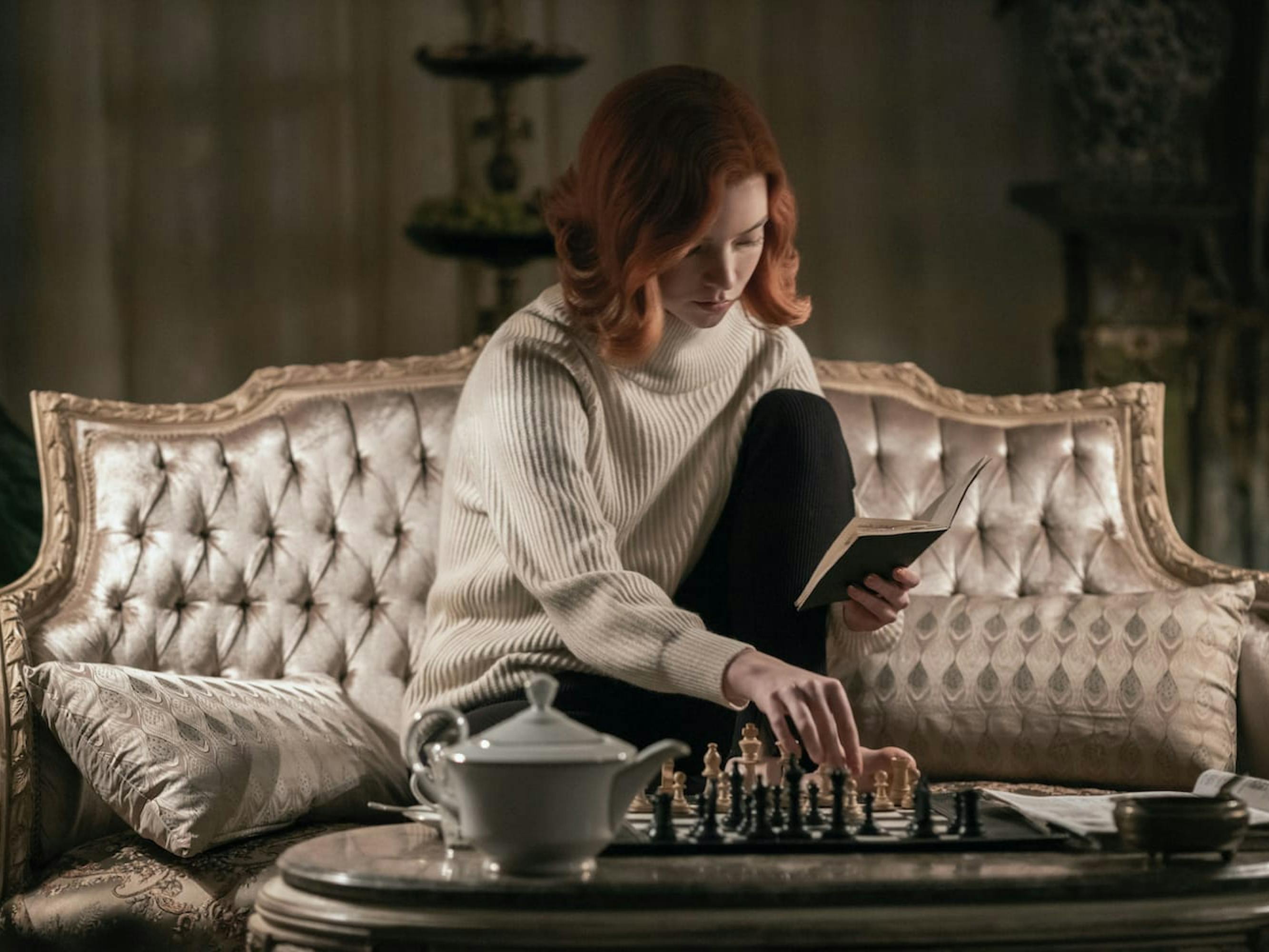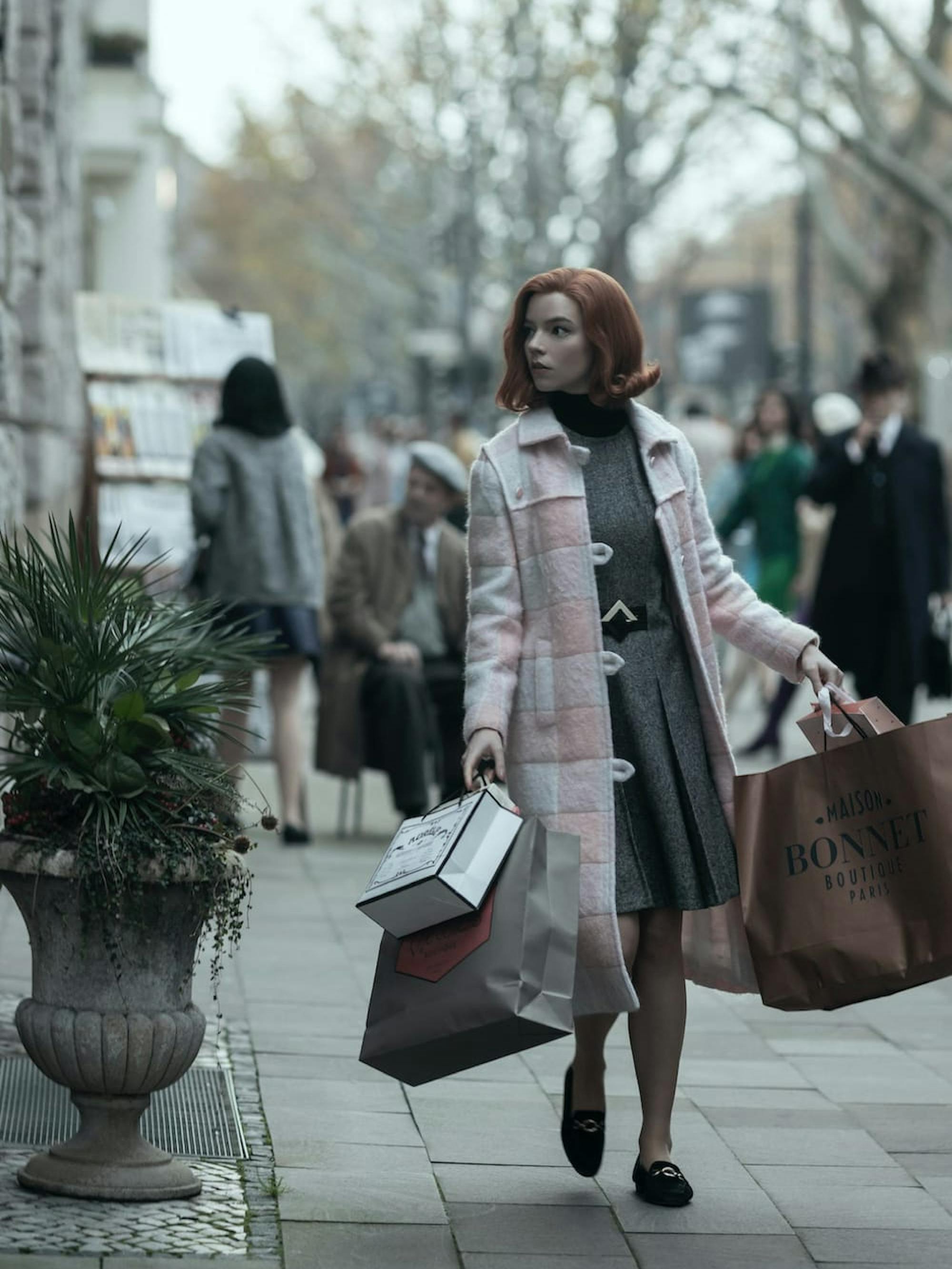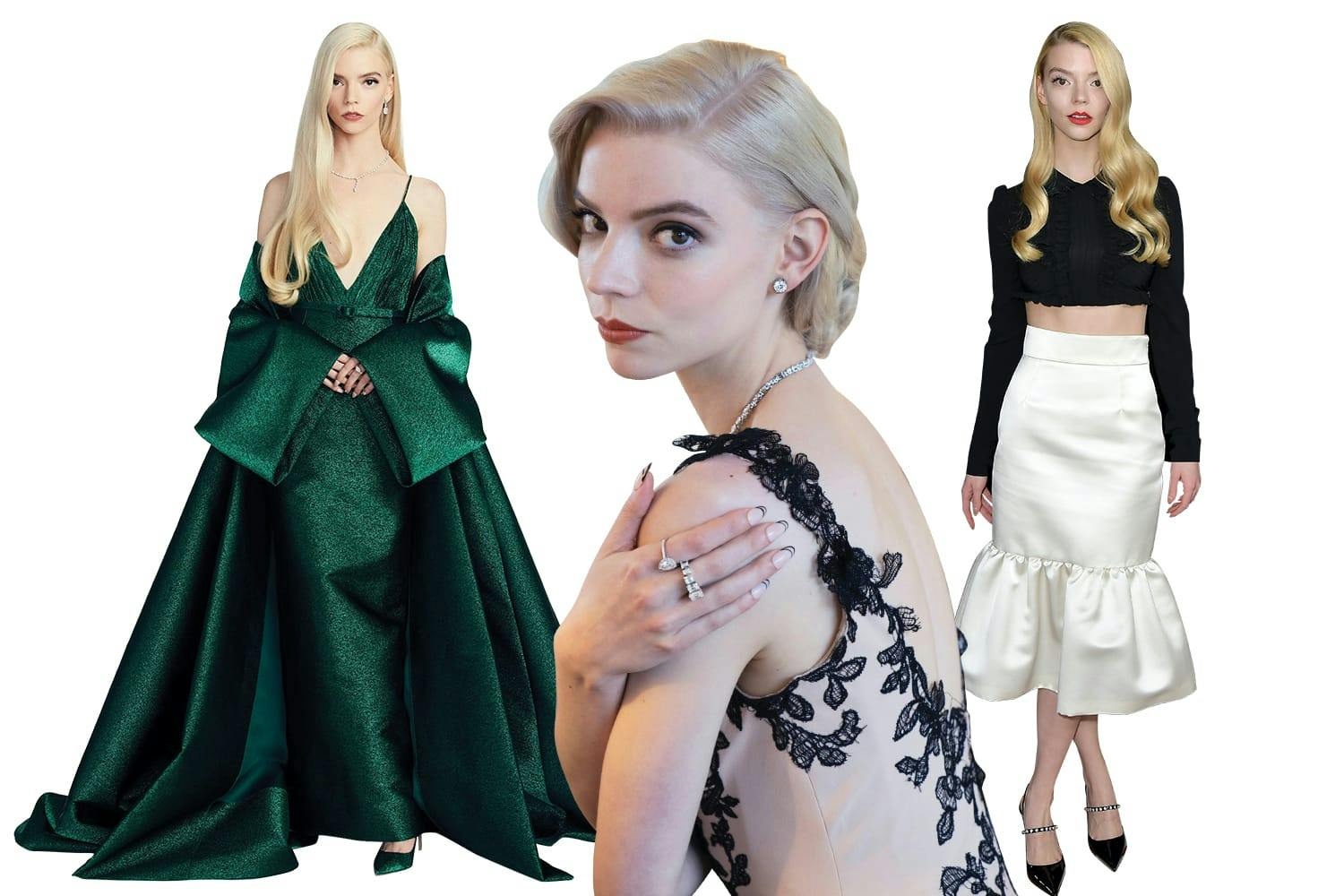The star considers life before and after the smash hit The Queen’s Gambit.
The Queen’s Gambit is, at root, a show about loneliness. The loneliness of being Beth Harmon: an orphan, a child prodigy, the rare woman in the hypermasculine world of competitive chess, and so talented that she stands apart from all her peers. There is also the numbing, alienating loneliness of addiction, the bassline accompaniment to Beth’s life; the loneliness of competition, of feeling you must win, whatever it costs you; and the universal loneliness of being human.
“I think we all suffer from existential loneliness to some degree,” says Anya Taylor-Joy, who played the teenaged and adult Beth, when we speak by phone late one afternoon. It is a Saturday in early April, the day after Taylor-Joy’s 25th birthday, and she is calling from New York City, on what she calls a “tiny break” from work (though she is obviously still working). To illustrate, she tells me that she’s currently walking around her apartment barefoot in “a giant bear coat with ears.” She laughs: “Like, that’s where I’m at right now.”
We discuss the overwhelming response to The Queen’s Gambit, which was viewed by 62 million households in its first 28 days, rendering it Netflix’s most-watched scripted limited series ever. Creator Scott Frank’s direction is noteworthy for its dramatic focus on Beth’s solitude: her isolation as she hallucinates chess pieces in motion on her bedroom ceiling, high on tranquilizers, or as she carouses around her house on a days-long bender after she’s botched a key tournament in Paris. I ask Taylor-Joy if she thinks viewers related to Beth more during this pandemic year, and she answers with the thoughtful, magnetic intensity of a young artist whose mind is set alight by ideas and who is eager to discuss them. “I think being lonely is perceived, or misperceived, as a kind of weakness,” she says. “Everyone goes through it, and it’s important to talk about it. The nice thing about existential loneliness is that everybody has it, so it’s inherently not lonely.”

She tells me that it has only recently dawned on her what a massive cultural phenomenon The Queen’s Gambit has become. The series led to a surge of interest in chess (Google searches for “chess” doubled in the past year), sent Walter Tevis’s 1983 novel, on which the series is based, to the New York Times best-seller list, and catapulted Taylor-Joy to global stardom. It must be strange, I suggest, to find yourself at the center of all that. “Strange, I think, is an understatement,” she replies. “I spent up until about two weeks ago living in quite a protective bubble. I understood the show was very well loved, but it hadn’t really changed my life that much.” Now, however, she has begun to feel the impact. “You just walk out onto the street and you realize that everybody knows your face,” she says. “At first, you’re like, Wait, do I have spinach — is there something wrong with my face? And then you’re like, Oh, they’ve just stared at seven hours of my face in close-up.”
Although Taylor-Joy repeatedly expresses gratitude for her opportunities and her recent success, I can’t help but wonder if sudden fame of this magnitude isn’t itself a bit isolating. But feeling out of place is not new to her, she says, and notes that of the many characters she’s played (approximately 25 so far in her seven-year career, with 5 of those projects not yet released), Beth Harmon was the one most like her, and for precisely this reason. “We both felt very out of water in... I guess you would call it ‘normal life,’” she explains. “And we both really needed to find where we fit in. Beth found chess, and I found making art. I’m forever grateful for that —forever grateful.” Taylor-Joy related to Beth so thoroughly that she knew from the outset that playing her would not require “any prep of any kind.” Instead, she says that the part called for “an ability to separate what Beth’s feelings were and what my feelings were. Otherwise you go onto set and you’re like, Why do I feel so awful?”

Perhaps it’s this act of conflation that accounts for Taylor-Joy’s seamless, riveting performance. Not for an instant is there a slippage where one glimpses the actor behind the character. It’s as though she exposed her deepest self in service of Beth. “She is very willing to be seen, which is not actually something everyone who is in front of the camera possesses — a desire to let the camera really in,” says Marielle Heller, who played Beth’s adoptive mother, Alma Wheatley. “She is very open in a way that is a bit disorienting at first.” The camera lingers on Taylor-Joy’s face, on her intense, expressive eyes. Chess is, after all, a game of intellect, and one can almost see Beth’s thoughts passing over her features like clouds. Moses Ingram, who played Jolene, Beth’s close friend and childhood confidante at the orphanage, notes that the two characters are united as fellow “outliers.” She calls Taylor-Joy a “brilliant listener,” and says you can see this still, receptive quality “in her eyes and in her body” as she portrays Beth.
Beth found chess, and I found making art. I’m forever grateful for that — forever grateful.
Anya Taylor-Joy
“I think only now am I able to be confident in my quote-unquote process,” says Taylor-Joy. “At the beginning, I would feel that these other actors all had their way of doing things that involved a lot of studying. I thought I was doing something wrong by not doing that.” Performing comes naturally to her; she has wanted to act since she was a teenager living in London. At 16, she was scouted by the head of a modeling agency while walking her dog in her mom’s high heels. “If you stop, you won’t regret it!” the man called after her, as she picked up the dog and ran. She did ultimately stop (“My survival instinct is terrible,” she jokes), and she and her parents visited the agency the next day. She went in, as she puts it, “pretty insistently saying, ‘I want to act. That is what I need to do with my life.’”
She was booked on three modeling shoots, one of them for Teen Vogue. On the third, for Love Magazine, she met the Irish actor Allen Leech, for whom she read a Seamus Heaney poem. Impressed, he introduced her to Kat Gosling, her agent to this day. “No photographs,” Taylor-Joy says matter-of-factly (the Love images never ran), “but it set me on this path.” Shortly thereafter, she wrote an essay for her parents that outlined, in great teenage detail, why she planned to quit high school and pursue a career in acting. “They were not pleased, I think is a gentle way of putting it,” she says, laughing. “But I just knew it. I was like, I just need to get out there and do this.” While preparing for her high school exams, she was cast in the supernatural folktale horror film The Witch, her breakout role.

About her childhood, she shares, “I was always very other.” She was born in Miami, but lived in Argentina until she was six, when her family moved to the U.K. “I didn’t speak a word of English, so I was really behind,” she says, in her undefinable accent, its British edges sanded down by other influences. But she learned to read in English, and books became a balm for her. “Once I could read,” she tells me, “I was really not that lonely ever again.” Still, she found “the social politics of school really difficult,” so she’d skip classes and head to the library, where she’d read in “a hidey-hole.” Reading is still a comfort for her; she estimates she’s read a book a day during lockdown. Among her recent favorites — she walks over to her bookshelves to look for me — are Giovanni’s Room by James Baldwin, The Descent of Man by Grayson Perry, Exquisite Mariposa by Fiona Alison Duncan, and My Contemporaries by Jean Cocteau. “I was a hundred percent that kid, and now I’m that adult, that if I’m reading something really good and have to go to dinner, I’m low-key resentful,” she says. At the recommendation of a friend, she is about to embark on Murakami for the first time.
I ran to meet Scott Frank. I’ve never physically run anywhere in my life!
Anya Taylor-Joy
It was, in fact, Walter Tevis’s novel that first drew her to the role of Beth. “I was ready to shoot her from the second I closed the book,” she says, “I ran to meet Scott Frank. I’ve never physically run anywhere in my life! I do not run, and I ran to meet this man, I was so excited.”
Although she did little character preparation, she did bone up on chess knowledge before shooting. “I needed to understand the theory of chess for myself,” she says. “I didn’t feel right showing up and not knowing anything about it. But,” she quickly adds, “understanding the theory and being able to apply it to a real game are two very different skills.” With the help of chess consultants Bruce Pandolfini and Garry Kasparov, she memorized the moves Beth makes in her games, calling them “dance choreography for my fingers.” Surprisingly, she did not find mastering them difficult “because Beth doesn’t.” As she tells me, “It’s kind of embodying somebody so completely that the things that are second nature to them are hopefully second nature to you.” She also came up with Beth’s signature balletic flourish as she handles the chess pieces: “I wanted it to be distinctive, I wanted it to be feminine, but I also wanted it to be aggressive,” she says. “You don’t even need to talk; you’re having an entire dialogue with just the way that you move those pieces.”

Taylor-Joy involved herself in other aspects of bringing the character to life as well. She worked closely with costume designer Gabriele Binder to enact “storytelling by sartorial means,” as Binder puts it. “Gabriele kind of instantly saw how wrapped up this person and I were in each other,” says Taylor-Joy. “She was like, ‘O.K., we’re doing hours of fittings, and we are planning out the clothes story’ — which is one of my favorite parts of filmmaking.” Adds Binder: “She had not any vanity at all and was always looking for the best solution to tell Beth, to be Beth. She did everything for Beth. It was really a love affair.” Through the clothes, the pair evoked the character’s transformation from an awkward orphan in ill-fitting garments to a confident grandmaster who wields fashion for her own pleasure. For example, there’s the flouncy green dress Beth throws on for the doomed match in Paris, which echoes the color of the pills she takes; and the snow-white outfit she wears in Russia, which nods to the white queen on the chessboard. Indeed, the series’ aestheticism is part of its significant appeal. Beth is not forced to choose between being cerebral and being sexy, and neither are viewers. “Chess can also be beautiful,” Beth says to a reporter interviewing her after she wins an early tournament.
As our interview winds down, Taylor-Joy emphasizes that she enjoys “every single aspect” of filmmaking. “If I’m not in front of the camera, I’m on set learning from any department that doesn’t find me too annoying,” she says. “I just love the whole thing.” She tells me she wants to direct someday, provided she finds the right story: “I don’t think I could ever direct just to direct.” Of course, every young star has plans to direct, but Taylor-Joy approaches her work with such singular intensity that you’re inclined to believe her. “You are essentially giving up your life to give life to somebody else,” she says of acting, “and that’s all you live and breathe. As I make more films, it has to be that same feeling. It has to be that feeling of, Oh my goodness, if I do not give this character a voice, it’s the end of the world. I won’t survive it.”
Events and awards shows may have been largely virtual this past year, but Anya Taylor-Joy dressed to impress at every turn. And while audiences certainly covet Beth’s wardrobe in The Queen’s Gambit (was there an uptick in vintage sales, we wonder?), they’ve fallen just as hard for Taylor-Joy’s own red-carpet looks. From her emerald Dior gown for the Golden Globes to a black-lace-trimmed Vera Wang dress for SAG, to hosting SNL, Taylor-Joy’s style deserves an award of its own.



